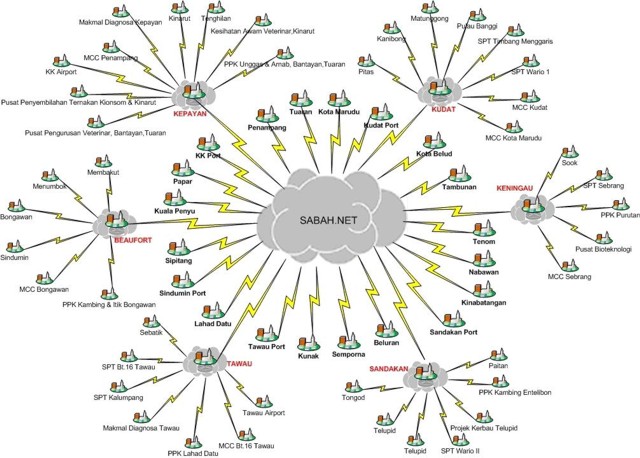
About DAVETSA
-
Export/Import (EXIM)
Enables exporters/importers to register for export/import licenses online. This module is linked to the Enforcement and Quarantine modules to allow inspections at entry points and quarantine if necessary. -
Penguatkuasaan (Enforcement)
Enables the monitoring and recording of the chronological enforcement cases from the confiscation of live animals or animals-by-product, police report, court order, final report to the disposal of animals and goods. -
Kuarantin (Quarantine)
Records the chronological progress and monitors the animals being quarantined, including clinical inspections and in-house quarantine processes. -
Makmal/Diagnostik/Klinik (Lab/Diagnostic/Clinic)
Records all laboratory and clinical diagnostic specimens being sent to the laboratory for disease detection. This includes specimen distribution and examination at laboratory level. -
Unit Epidemiologi (Epidemiology Unit)
Supports the basic surveillance functions such as data collection, evaluation, interpretation and refinement. Allows the veterinary services to demonstrate whether a particular disease does or does not reside. -
Farmasi Veterinar (Veterinary Pharmacy)
A mini inventory system having the functions of recording and managing the veterinary drugs, non-drugs and stationery. It also allows district officers to indent items from the pharmacy online. -
Latihan (Training)
Allows the public and government officers to apply online for courses and trainings. Also allows officers and supervisors to comment and evaluate trainees? performance. -
Pengurusan Projek (Project Management)
Allows users to manage project budgets in terms of estimating, evaluating and monitoring the projects financially and physically. -
Bantuan Projek (Project Subsidy)
Processes and manages the applications of the project subsidies. Also allows the public to apply project subsidies offered by DOVSAI online. -
Pemantauan Lawatan Terancang Berjadual (LTJ) (LTJ Monitoring)
Records and monitors activities carried out by the district officers for the Lawatan Terancang Berjadual (LTJ). -
Tenusu (Dairy)
Monitors and records dairy production and collection from the farmers. -
Ladang (Farm)
Module to monitor the activities carried out at all farms under DOVSAI. -
Quality Assurance Program (QAP)
Records and monitors the implementation of the quality control programs on the farms for animal industry in Sabah. -
Laporan (Reporting)
Processes data from all the modules to generate all relevant reports from district level up to headquarter level.
With this system DOVSAI is able to collect up-to-date data statewide which will form the core of the Veterinary Databank (DAVETSA). The system enables DOVSAI to use the databank for data mining which assists in better decision-making based on the most current information.

The DAVETSA system is designed with four important considerations in mind - flexibility, scalability, redundancy, ease of use and security. This solution is entirely web-based and is built upon a rules-based architecture which supports single sign-on for authentication. It provides DOVSAI with a centralized platform for streamlining multiple applications - improving employee productivity and reducing administration and maintenance costs. In addition, this solution is completely independent from the backend server i.e. it can work with any database including Oracle, MS SQL Server, MySql etc.
The front end of the system is a portal which has an easy-to-use interface which can be accessed by different levels of users. The back-end of the system is the integrated information system which consists of the systematic management of various aspects in DOVSAI's operations.
The DAVETSA system is deployed statewide covering all six KPAs (Key Production Areas) allowing access and data collection from all 61 DOVSAI sites throughout the state. This system is tapping on the current Sabah.Net infrastructure. This allows the system to be very secure and supported by a highly redundant infrastructure and at the same time optimize the spending needed for the project. By doing so, it reduces duplication in terms of security and also long distance connectivity and allow for better systems to be developed.
The DAVETSA system allows DOVSAI to reach the goal in increasing the efficiency of the operation and support a better decision making based on the most up to date information.
The Network modules in DAVETSA consist of the Wide-Area Network (WAN) and Local-Area Network (LAN). The WAN connection is where the connection of the main nodes / backbone link (where the point of presence is identified as the location of the Dial-up servers) and the LAN connection is where the internal connection between the routers, switches and pc?s are located. Diagram below is the logical WAN connectivity of how the links are interconnected. They are linked back to each other via the identified primary sites where the servers are located and then through the Sabah.Net backbone to complete the state wide connection.
The main nodes which are identified as Daerah Penuh are inter-connected to the Sabah.Net backbone and are where the rest of the remote sites on the same Key Production Area (KPA) will be connected to. The stations / Daerah kecil are connected to the nodes via dial up where the connection will be on-demand basis.